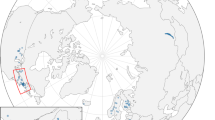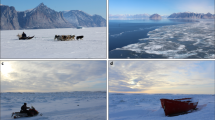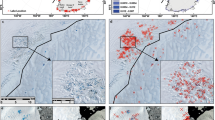Abstract
Ice provides a range of ecosystem services—including fish harvest1, cultural traditions2, transportation3, recreation4 and regulation of the hydrological cycle5—to more than half of the world’s 117 million lakes. One of the earliest observed impacts of climatic warming has been the loss of freshwater ice6, with corresponding climatic and ecological consequences7. However, while trends in ice cover phenology have been widely documented2,6,8,9, a comprehensive large-scale assessment of lake ice loss is absent. Here, using observations from 513 lakes around the Northern Hemisphere, we identify lakes vulnerable to ice-free winters. Our analyses reveal the importance of air temperature, lake depth, elevation and shoreline complexity in governing ice cover. We estimate that 14,800 lakes currently experience intermittent winter ice cover, increasing to 35,300 and 230,400 at 2 and 8 °C, respectively, and impacting up to 394 and 656 million people. Our study illustrates that an extensive loss of lake ice will occur within the next generation, stressing the importance of climate mitigation strategies to preserve ecosystem structure and function, as well as local winter cultural heritage.
This is a preview of subscription content, access via your institution
Access options
Access Nature and 54 other Nature Portfolio journals
Get Nature+, our best-value online-access subscription
$29.99 / 30 days
cancel any time
Subscribe to this journal
Receive 12 print issues and online access
$209.00 per year
only $17.42 per issue
Buy this article
- Purchase on Springer Link
- Instant access to full article PDF
Prices may be subject to local taxes which are calculated during checkout




Similar content being viewed by others
Data availability
The ice phenology record, as well as location, mean depth, surface area and elevation data, were sourced from the US National Snow and Ice Data Center Lake and River Ice Phenology database, which was updated through the 2017–2018 winter11. We acquired additional information (shoreline complexity and length, residence time, volume, mean discharge, slope within 100m of the lake shore and watershed area) for each of these lakes from the HydroLAKES database18. We acquired climate information for each lake (mean annual air temperature for 1970–2010) from the CRU30. Data that support the findings of this study are available at https://portal.edirepository.org/nis/mapbrowse?packageid=edi.267.2.
References
Orru, K., Kangur, K., Kangur, P., Ginter, K. & Kangur, A. Recreational ice fishing on the large Lake Peipsi: socioeconomic importance, variability of ice-cover period, and possible implications for fish stocks. Est. J. Ecol. 63, 282–298 (2014).
Sharma, S. et al. Direct observations of ice seasonality reveal changes in climate over the past 320–570 years. Sci. Rep. 6, 25061 (2016).
Hori, Y., Cheng, V. Y. S., Gough, W. A., Jien, J. Y. & Tsuji, L. J. S. Implications of projected climate change on winter road systems in Ontario’s Far North, Canada. Clim. Change 148, 109–122 (2018).
Brammer, J., Samson, J. & Humphries, M. M. Declining availability of outdoor skating in Canada. Nat. Clim. Change 5, 2–4 (2014).
Wang, W. et al. Global lake evaporation accelerated by changes in surface energy allocation in a warmer climate. Nat. Geosci. 11, 410–414 (2018).
Walsh, S. E. et al. Global patterns of lake ice phenology and climate: model simulations and observations. J. Geophys. Res. 103, 28825–28837 (1998).
Brown, L. C. & Duguay, C. R. The response and role of ice cover in lake–climate interactions. Prog. Phys. Geogr. 34, 671–704 (2010).
Magnuson, J. J. et al. Historical trends in lake and river ice cover in the Northern Hemisphere. Science 289, 1743–1746 (2000).
Weyhenmeyer, G. A. et al. Large geographical differences in the sensitivity of ice-covered lakes and rivers in the Northern Hemisphere to temperature changes. Glob. Change Biol. 17, 268–275 (2011).
Magnuson, J. J. & Lathrop, R. C. Lake ice: winter, beauty, value, changes, and a threatened future. LakeLine 43, 18–27 (2014).
Benson, B. J. et al. Extreme events, trends, and variability in Northern Hemisphere lake-ice phenology (1855–2005). Clim. Change 112, 299–323 (2012).
Leppäranta, M. in The Impact of Climate Change on European Lakes (ed. George, G.) 63–83 (Springer, Dordrecht, 2010).
Nõges, P. & Nõges, T. Weak trends in ice phenology of Estonian large lakes despite significant warming trends. Hydrobiologia 731, 5–18 (2014).
Kirillin, G. et al. Physics of seasonally ice-covered lakes: a review. Aquat. Sci. 74, 659–682 (2012).
Palecki, M. A. & Barry, R. G. Freeze-up of lakes as an index of temperature changes during the transition seasons: a case study for Finland. Am. Meteorol. Soc. 25, 893–902 (1986).
Duguay, C. R. et al. Recent trends in Canadian lake ice cover. Hydrological Proc. 20, 781–801 (2006).
Benson, B. J. & Magnuson, J. J. Global Lake and River Ice Phenology Database (National Snow and Ice Data Center, 2012).
Messager, M. L., Lehner, B., Grill, G., Nedeva, I. & Schmitt, O. Estimating the volume and age of water stored in global lakes using a geo-statistical approach. Nat. Commun. 7, 13603 (2016).
Screen, J. A. Arctic amplification decreases temperature variance in northern mid- to high-latitudes. Nat. Clim. Change 4, 577–582 (2014).
Xiao, K. et al. Evaporation from a temperate closed-basin lake and its impact on present, past, and future water level. J. Hydrology 561, 59–75 (2018).
Prowse, T. et al. Effects of changes in Arctic lake and river ice. Ambio 40, 63–74 (2011).
National Survey of Fishing, Hunting, and Wildlife-Associated Recreation (US Department of the Interior, US Fish and Wildlife Service, US Department of Commerce & US Census Bureau, 2011).
Guiness World Records Guiness Book of World Records 2008 463 (Bantam Books, New York, 2008).
Moodley, K. Amazing aerial footage shows 100,000 people at China’s ice fishing festival. The Independent www.independent.co.uk/news/world/asia/amazing-aerial-footage-shows-100000-people-at-chinas-ice-fishing-festival-9950281.html (2014).
Hampton, S. E. et al. Ecology under lake ice. Ecol. Lett. 20, 98–111 (2017).
Blank, K., Haberman, J., Haldna, M. & Laugaste, R. Effect of winter conditions on spring nutrient concentrations and plankton in a large shallow Lake Peipsi (Estonia/Russia). Aquat. Ecol. 43, 745–753 (2009).
Weyhenmeyer, G. A., Westoo, A.-K. & Willen, E. Increasingly ice free winters and their effects on water quality in Sweden’s largest lakes. Hydrobiologia 599, 111–118 (2008).
Farmer, T. M., Marschall, E. A., Dabrowski, K. & Ludsin, S. A. Short winters threaten temperate fish populations. Nat. Commun. 6, 7724 (2015).
Carrea, L., Embury, O. & Merchant, C. J. GloboLakes: high-resolution global limnology dataset v1 (Centre for Environmental Data Analysis, 2015); https://doi.org/10.5285/6be871bc-9572-4345-bb9a-2c42d9d85ceb
Harris, I., Jones, P. D., Osborn, T. J. & Lister, D. H. Updated high-resolution grids of monthly climatic observations—the CRU TS3.10 Dataset. Int. J. Climatol. 34, 623–642 (2014).
CIESIN Gridded Population of the World, Version 4 (GPWv4). Population count adjusted to match 2015 revision of UN WPP country totals, Revision 10. NASA SEDAC https://doi.org/10.7927/H4JQ0XZW (2017).
De'ath, G. & Fabricius, K. E. Classification and regression trees: a powerful yet simple technique for ecological data analysis. Ecology 81, 3178–3192 (2000).
O’Reilly, C. M. et al. Rapid and highly variable warming of lake surface water temperatures around the globe. Geophys. Res. Lett. 42, 10773–10781 (2015).
Warren, R., Price, J., Graham, N., Forstenhaeusler, N. & Van Der Wal, J. The projected effect on insects, vertebrates, and plants of limiting global warming to 1.5°C rather than 2°C. Science 360, 791–795 (2018).
Acknowledgements
We are indebted to the numerous data providers who shared and updated their ice phenology records for the National Snow and Ice Data Center Lake and River Ice Phenology database. We thank A. Kuthakumar, T. Sadid and A. Shuvo for gathering lake morphology data from the literature. Funding was provided to S.S. by the Ontario Ministry of Research, Innovation and Science Early Researcher Award, York University Research Chair programme and Natural Sciences and Engineering Research Council of Canada. S.O. was partially supported by funding from the Department of the Interior Northeast Climate Science Center. Most data used in this manuscript are publicly available. The lake ice records were made available through the Long Term Ecological Research Network. In addition, the North Temperate Lakes Long Term Ecological Research (NSF number DEB-1440297) programme provided data, funding and participation support for this project. Any use of trade, firm or product names is for descriptive purposes only and does not imply endorsement by the US Government. This work was supported by the Global Lake Ecological Observatory Network. We thank K. Jankowski for constructive comments that improved the manuscript.
Author information
Authors and Affiliations
Contributions
S.S. and J.J.M. conceived the idea for the project. S.S. led the project. S.S., K.B., C.M.O., S.O., M.R.M., D.S., G.A.W., L.W. and R.I.W. collected the data. S.S., K.B. and S.O. conducted the data analysis. S.S., K.B., S.O. and C.M.O. drafted the figures and tables. S.S., K.B., C.M.O., S.O., R.D.B., M.R.M., D.S., G.A.W., L.W., R.I.W. and J.J.M. discussed the results, wrote sections of the text, provided critical feedback and commented on drafts of the manuscript.
Corresponding author
Ethics declarations
Competing interests
The authors declare no competing interests.
Additional information
Journal peer review information: Nature Climate Change thanks Tiina Noges and Grant Gunn for their contribution to the peer review of this work.
Publisher’s note: Springer Nature remains neutral with regard to jurisdictional claims in published maps and institutional affiliations.
Supplementary information
Supplementary Information
Supplementary Figures 1–3, Supplementary Tables 1–2
Rights and permissions
About this article
Cite this article
Sharma, S., Blagrave, K., Magnuson, J.J. et al. Widespread loss of lake ice around the Northern Hemisphere in a warming world. Nat. Clim. Chang. 9, 227–231 (2019). https://doi.org/10.1038/s41558-018-0393-5
Received:
Accepted:
Published:
Issue Date:
DOI: https://doi.org/10.1038/s41558-018-0393-5
This article is cited by
-
River freeze-up date anomalies during the sixteenth to nineteenth centuries in southern Northeast China reconstructed from the Korean Envoys Yanxing Book
Climatic Change (2024)
-
Indicators of the effects of climate change on freshwater ecosystems
Climatic Change (2023)
-
Projecting climate change impacts on ice phenology across Midwestern and Northeastern United States lakes
Climatic Change (2023)
-
The response of aquatic ecosystems to the interactive effects of stratospheric ozone depletion, UV radiation, and climate change
Photochemical & Photobiological Sciences (2023)
-
Effect of Climate Change on Water Temperature and Stratification of a Small, Temperate, Karstic Lake (Lake Kozjak, Croatia)
Environmental Processes (2023)



